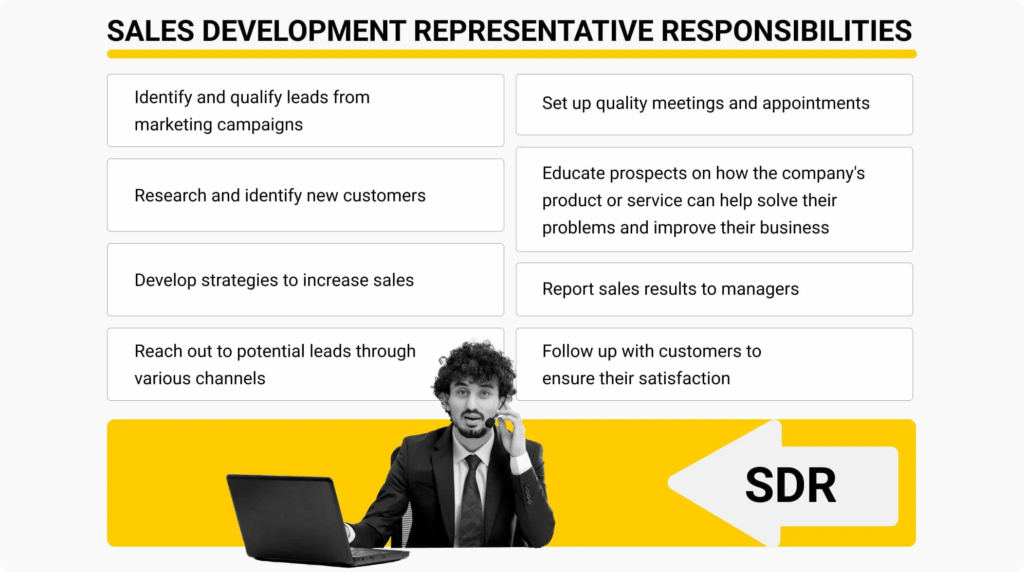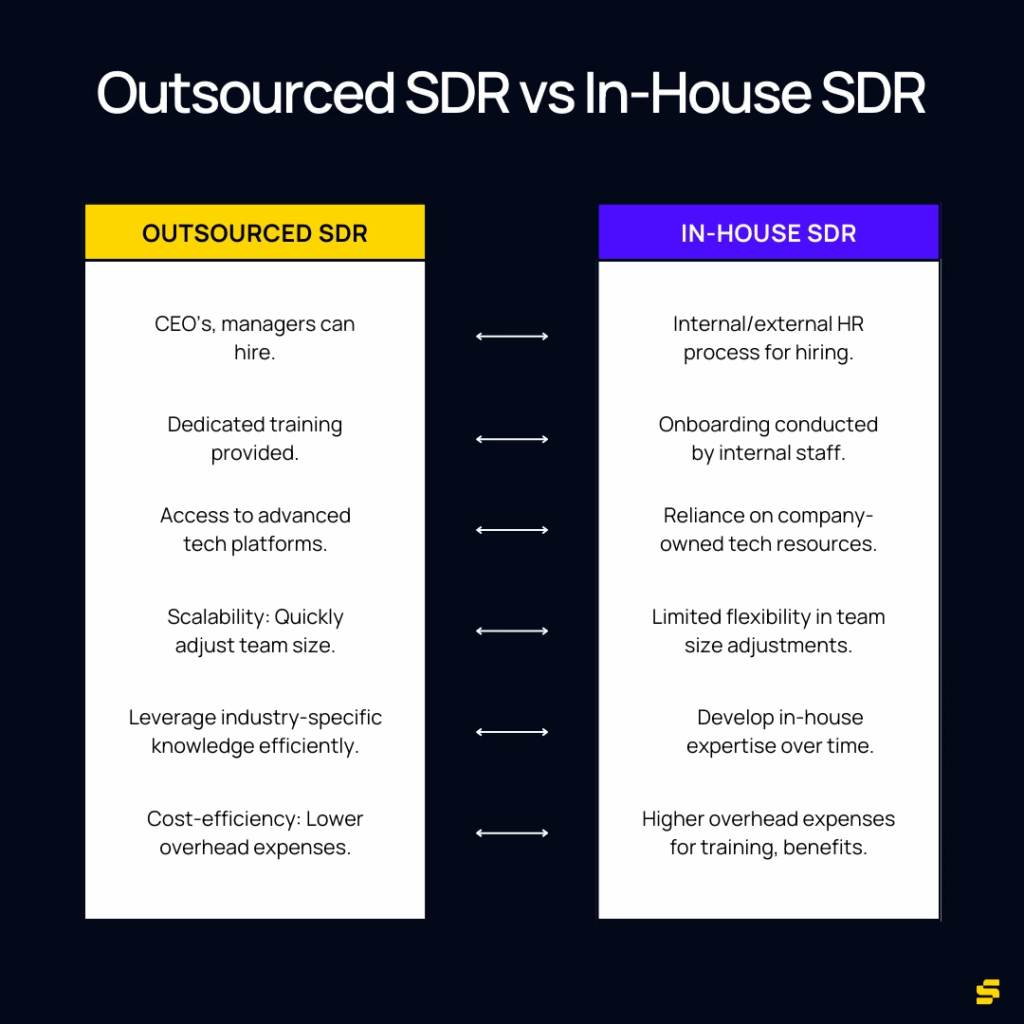How to Choose Between In-House vs Outsourced SDR Teams
For growing B2B organizations, sales development representatives (SDRs) play a central role in driving qualified pipeline. They handle prospecting, outreach, and the crucial first interactions that convert marketing interest into real opportunities. The challenge many revenue leaders face is deciding whether to manage this team internally or outsource it to a specialized partner.
Both approaches can produce strong results when executed correctly. An in-house team offers direct control and alignment, while an outsourced SDR team delivers scalability and speed. The right choice depends on company goals, resources, and how quickly you need measurable outcomes.
Quick Takeaways
- The choice between in-house and outsourced SDR teams depends on control, cost, scalability, and expertise.
- In-house SDRs provide brand familiarity and cultural alignment but require significant time and investment.
- Outsourced SDR teams offer immediate ramp-up, proven processes, and advanced technology.
- Evaluate based on readiness, available infrastructure, and long-term growth objectives.
Understanding the Role of SDRs
SDRs bridge the gap between marketing and sales. They qualify inbound leads, conduct outbound outreach, and set appointments with decision-makers. Their success directly affects sales velocity and revenue forecasting.
For leadership, the question is less about whether SDRs are necessary and more about how to structure them for maximum efficiency. This choice impacts everything from operational cost to pipeline consistency.

The Case for an In-House SDR Team
Control and Cultural Fit
Building an SDR team internally gives complete oversight of training, performance, and messaging. Reps operate within the company culture and have a deeper understanding of your products, tone, and brand values. This can enhance personalization during outreach and strengthen brand credibility.
An internal structure also allows leaders to adjust priorities quickly—adding focus to certain territories, product lines, or buyer segments as strategy evolves.
Skill Development and Collaboration
In-house teams gain exposure to cross-department collaboration with marketing, product, and customer success. This proximity builds shared accountability and speeds feedback loops, making it easier to refine messaging and campaign strategy.
Over time, in-house SDRs can progress into account executive or customer success roles, creating a natural talent pipeline within the organization.
Challenges of Managing Internally
However, building an in-house SDR function requires significant commitment. Recruiting, training, and retaining qualified talent demand both time and expense. Performance inconsistency is also common, especially in early stages before processes mature.
Maintaining technology stacks (CRM integrations, dialers, enrichment tools, and analytics) adds additional complexity. For smaller or rapidly growing companies, this can divert attention from strategic priorities.

The Case for an Outsourced SDR Team
Faster Ramp-Up and Scalability
An outsourced SDR team provides an immediate path to scale. These firms maintain trained representatives, established workflows, and integrated technology. That allows organizations to launch programs in weeks rather than months.
Partners can flex resources up or down based on campaign demand, seasonal trends, or market expansion. This agility makes outsourcing ideal for organizations pursuing aggressive growth goals without the overhead of building from scratch.
Access to Expertise and Proven Processes
Outsourced SDR firms specialize in prospect engagement. They refine outreach methods through data across industries, giving clients access to performance benchmarks and best practices. Their experience with advanced segmentation, automation, and analytics tools leads to faster optimization cycles and stronger conversion rates.
A mature partner also brings structured playbooks, ensuring consistent communication quality across every prospect interaction.
Cost Efficiency and Resource Focus
Outsourcing converts fixed headcount costs into variable expenses. Companies pay for performance rather than maintaining salaries, benefits, and infrastructure. This model lowers financial risk while freeing internal resources to focus on strategy and relationship management.
For organizations with limited bandwidth, outsourcing eliminates recruiting cycles and reduces the time needed to reach productivity.
Key Factors to Consider
1. Growth Stage and Internal Bandwidth
Early-stage or high-growth companies may lack the internal bandwidth to build an SDR function. Outsourced partners can accelerate pipeline creation while internal teams focus on refining product-market fit and sales strategy.
Established organizations with mature processes might prefer in-house control for deeper integration and long-term development.
2. Cost and Resource Allocation
An in-house team requires ongoing investment in hiring, onboarding, management, and technology. Outsourced models offer predictable monthly costs and immediate infrastructure.
To compare accurately, calculate the total cost of ownership (TCO) for each approach (including recruiting, training, software, and performance management) and weigh that against expected revenue contribution.
3. Quality Control and Brand Representation
Brand voice consistency matters in early prospect conversations. In-house SDRs often understand nuances better, while outsourced teams need structured onboarding to mirror your tone and value proposition accurately.
Many top outsourcing firms now integrate directly with marketing teams to ensure messaging alignment, mitigating this concern.
4. Technology Integration and Data Visibility
Data synchronization between systems is critical for performance tracking. Before outsourcing, verify that the partner’s CRM and analytics tools integrate seamlessly with your own.
Shared dashboards and defined data ownership keep both parties accountable and ensure transparent ROI measurement.
5. Speed to Market
If speed is a priority, outsourcing provides the advantage. Firms with ready-to-deploy SDRs eliminate the ramp-up period associated with internal hiring. For new product launches or regional expansion, this can accelerate time-to-revenue substantially.
When a Hybrid Model Works Best
Many organizations adopt a hybrid approach, combining internal leadership with outsourced execution. In this model, in-house SDRs focus on strategic or enterprise accounts, while the partner manages high-volume outreach or specific regions.
A hybrid strategy provides balance; retaining brand control while leveraging partner expertise and scalability. When structured properly, it creates a continuous pipeline without overextending internal resources.
How to Evaluate Outsourced SDR Partners
Before selecting a provider, CROs and CMOs should review:
- Experience in your industry or vertical
- Performance metrics such as meetings booked, conversion rates, and pipeline contribution
- Reporting transparency and CRM integration capability
- Cultural alignment and communication cadence
- References or case studies demonstrating measurable ROI
Schedule pilot programs or limited campaigns to assess fit before full engagement. Continuous feedback loops and defined performance reviews ensure quality remains high.
Common Misconceptions About Outsourced SDR Teams
- Outsourcing sacrifices control. With clear expectations, shared dashboards, and regular check-ins, transparency equals that of internal teams.
- External reps can’t understand complex offerings. Many providers train their SDRs on product knowledge and value messaging before campaigns launch.
- It’s only a short-term fix. Outsourced partnerships can support long-term strategies through scalable, data-driven engagement models that evolve with business needs.
Choose the Right Path Today with Televerde
Deciding between an in-house SDR team and an outsourced partner depends on your company’s stage, resources, and priorities. In-house teams deliver cultural alignment and long-term development potential, while outsourced SDR teams provide speed, expertise, and cost flexibility.
The most successful organizations assess their readiness carefully, aligning this decision with broader revenue objectives. Whether you build internally, outsource, or adopt a hybrid model, the goal remains the same: create a sales development engine that drives consistent, measurable growth.
Ready to scale your sales outreach with confidence? Discover how Televerde’s outsourced SDR teams help B2B organizations build qualified pipelines, strengthen alignment, and accelerate revenue. Contact us to learn more.


